steering Lexus IS250 2008 Using the air conditioning system and defogger / LEXUS 2008 IS250 (OM53699U) Workshop Manual
[x] Cancel search | Manufacturer: LEXUS, Model Year: 2008, Model line: IS250, Model: Lexus IS250 2008Pages: 464, PDF Size: 6.61 MB
Page 331 of 464
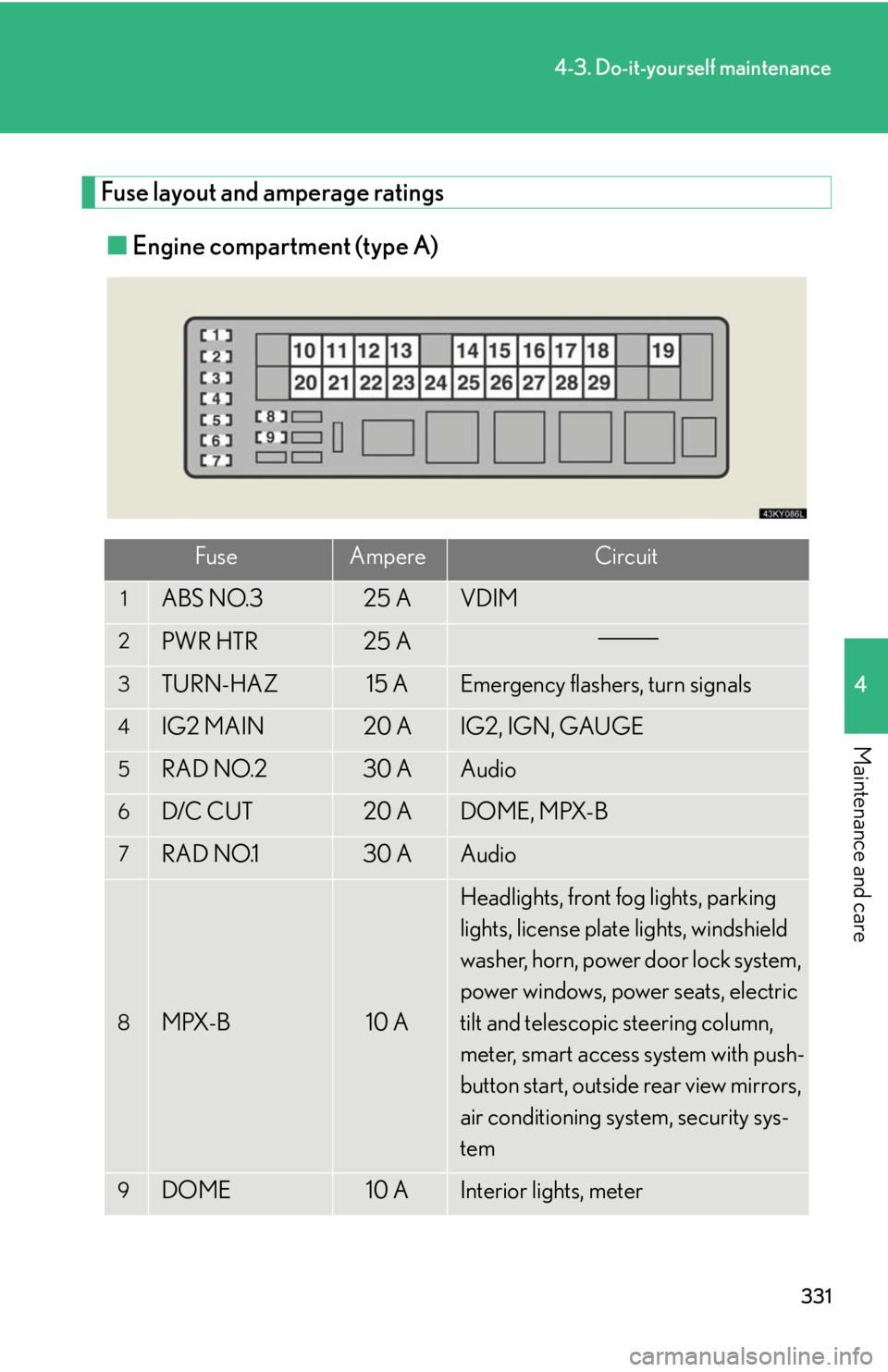
331
4-3. Do-it-yourself maintenance
4
Maintenance and care
Fuse layout and amperage ratings■ Engine compartment (type A)
FuseAmpereCircuit
1ABS NO.325 AVDIM
2PWR HTR25 A
3TURN-HAZ15 AEmergency flashers, turn signals
4IG2 MAIN20 AIG2, IGN, GAUGE
5RAD NO.230 AAudio
6D/C CUT20 ADOME, MPX-B
7RAD NO.130 AAudio
8MPX-B10 A
Headlights, front fog lights, parking
lights, license plate lights, windshield
washer, horn, power door lock system,
power windows, power seats, electric
tilt and telescopic steering column,
meter, smart access system with push-
button start, outside rear view mirrors,
air conditioning system, security sys-
tem
9DOME10 AInterior lights, meter
Page 332 of 464
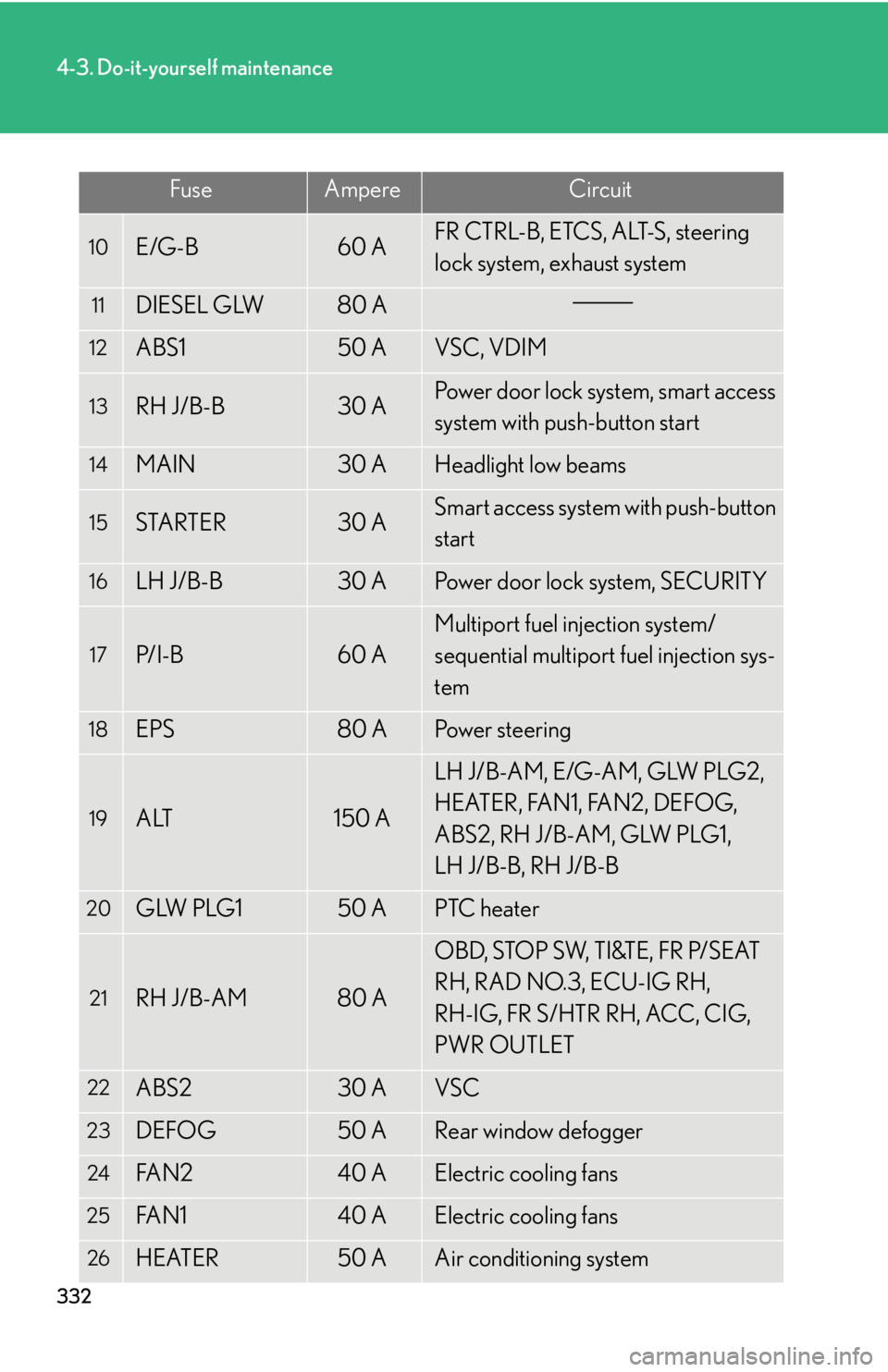
332
4-3. Do-it-yourself maintenance
FuseAmpereCircuit
10E/G-B60 AFR CTRL-B, ETCS, ALT-S, steering
lock system, exhaust system
11DIESEL GLW80 A
12ABS150 AVSC, VDIM
13RH J/B-B30 APower door lock system, smart access
system with push-button start
14MAIN30 AHeadlight low beams
15STARTER30 ASmart access system with push-button
start
16LH J/B-B30 APower door lock system, SECURITY
17P/I-B60 A
Multiport fuel injection system/
sequential multiport fuel injection sys-
tem
18EPS80 APower steering
19ALT150 A
LH J/B-AM, E/G-AM, GLW PLG2,
H E AT E R , FA N 1 , FA N 2 , D E F O G,
ABS2, RH J/B-AM, GLW PLG1,
LH J/B-B, RH J/B-B
20GLW PLG150 APTC heater
21RH J/B-AM80 A
OBD, STOP SW, TI&TE, FR P/SEAT
RH, RAD NO.3, ECU-IG RH,
RH-IG, FR S/HTR RH, ACC, CIG,
PWR OUTLET
22ABS230 AVSC
23DEFOG50 ARear window defogger
24FA N 240 AElectric cooling fans
25FA N 140 AElectric cooling fans
26HEATER50 AAir conditioning system
Page 334 of 464

334
4-3. Do-it-yourself maintenance
■Engine compartment (type B)
FuseAmpereCircuit
1FR CTRL-B25 AHeadlight high beam, horn
2A/F15 AExhaust system
3ETCS10 A
Multiport fuel injection system/
sequential multiport fuel injection sys-
tem
4ALT-S7. 5 ACharging system
5STR LOCK25 ASteering lock
6H-LP CLN30 AHeadlight cleaner
7A/C COMP7. 5 AAir conditioning system
8DEICER25 A
9FR CTRL-AM30 AFront fog lights, parking lights, wind-
shield washer
10IG210 AIgnition system
11EFI NO.210 AFuel system, exhaust system
12H-LP R LWR15 AHeadlight low beam (right)
13H-LP L LWR15 AHeadlight low beam (left)
Page 336 of 464
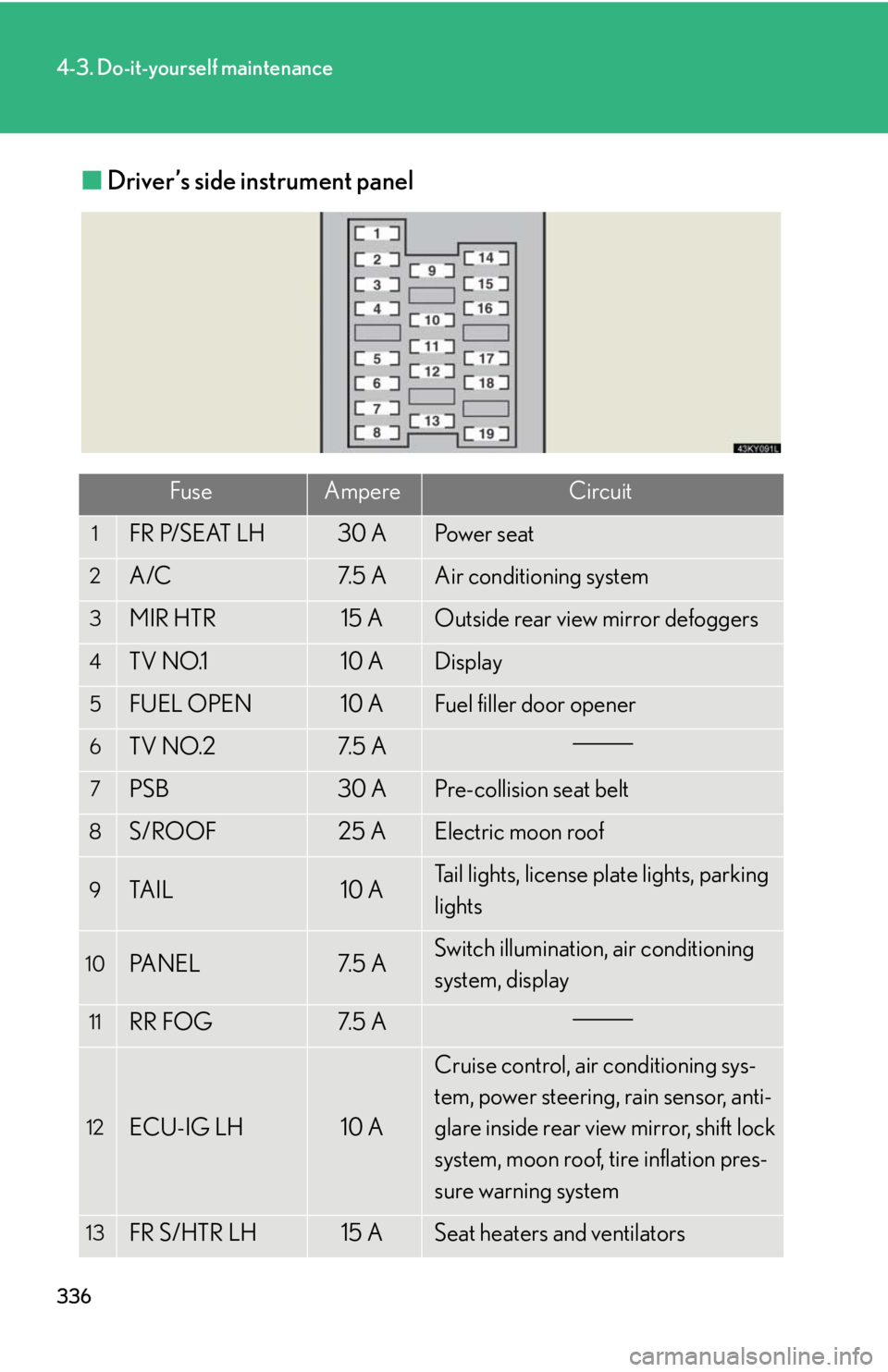
336
4-3. Do-it-yourself maintenance
■Driver’s side instrument panel
FuseAmpereCircuit
1FR P/SEAT LH30 APo w e r s e a t
2A/C7. 5 AAir conditioning system
3MIR HTR15 AOutside rear view mirror defoggers
4TV NO.110 ADisplay
5FUEL OPEN10 AFuel filler door opener
6TV NO.27. 5 A
7PSB30 APre-collision seat belt
8S/ROOF25 AElectric moon roof
9TA I L10 ATail lights, license plate lights, parking
lights
10PA N E L7. 5 ASwitch illumination, air conditioning
system, display
11RR FOG7. 5 A
12ECU-IG LH10 A
Cruise control, air conditioning sys-
tem, power steering, rain sensor, anti-
glare inside rear view mirror, shift lock
system, moon roof, tire inflation pres-
sure warning system
13FR S/HTR LH15 ASeat heaters and ventilators
Page 338 of 464
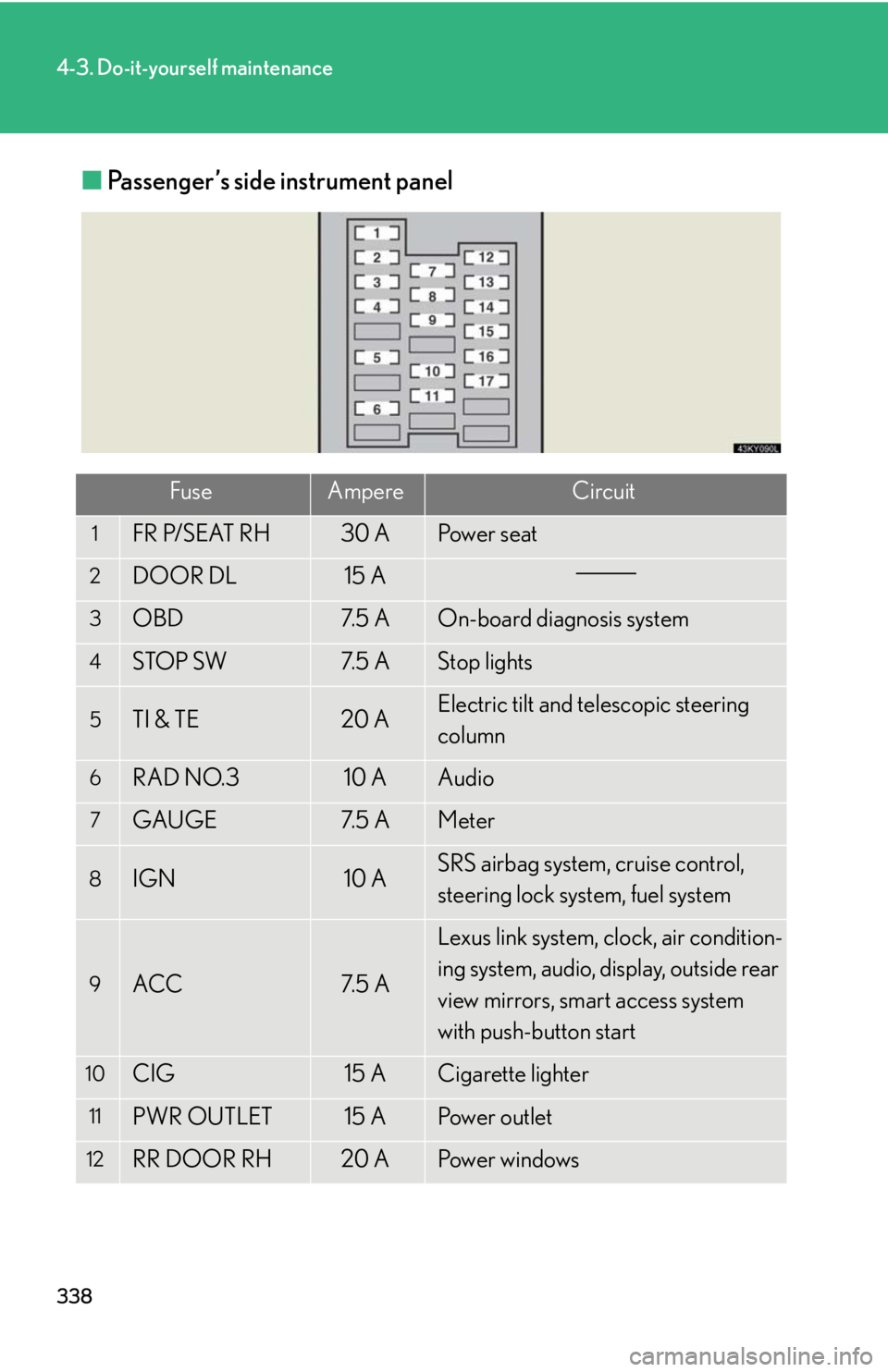
338
4-3. Do-it-yourself maintenance
■Passenger’s side instrument panel
FuseAmpereCircuit
1FR P/SEAT RH30 APo w e r s e a t
2DOOR DL15 A
3OBD7. 5 AOn-board diagnosis system
4STOP SW7. 5 AStop lights
5TI & TE20 AElectric tilt and telescopic steering
column
6RAD NO.310 AAudio
7GAUGE7. 5 AMeter
8IGN10 ASRS airbag system, cruise control,
steering lock system, fuel system
9ACC7. 5 A
Lexus link system, clock, air condition-
ing system, audio, display, outside rear
view mirrors, smart access system
with push-button start
10CIG15 ACigarette lighter
11PWR OUTLET15 APo w e r o u t l e t
12RR DOOR RH20 APo w e r w i n d o w s
Page 339 of 464
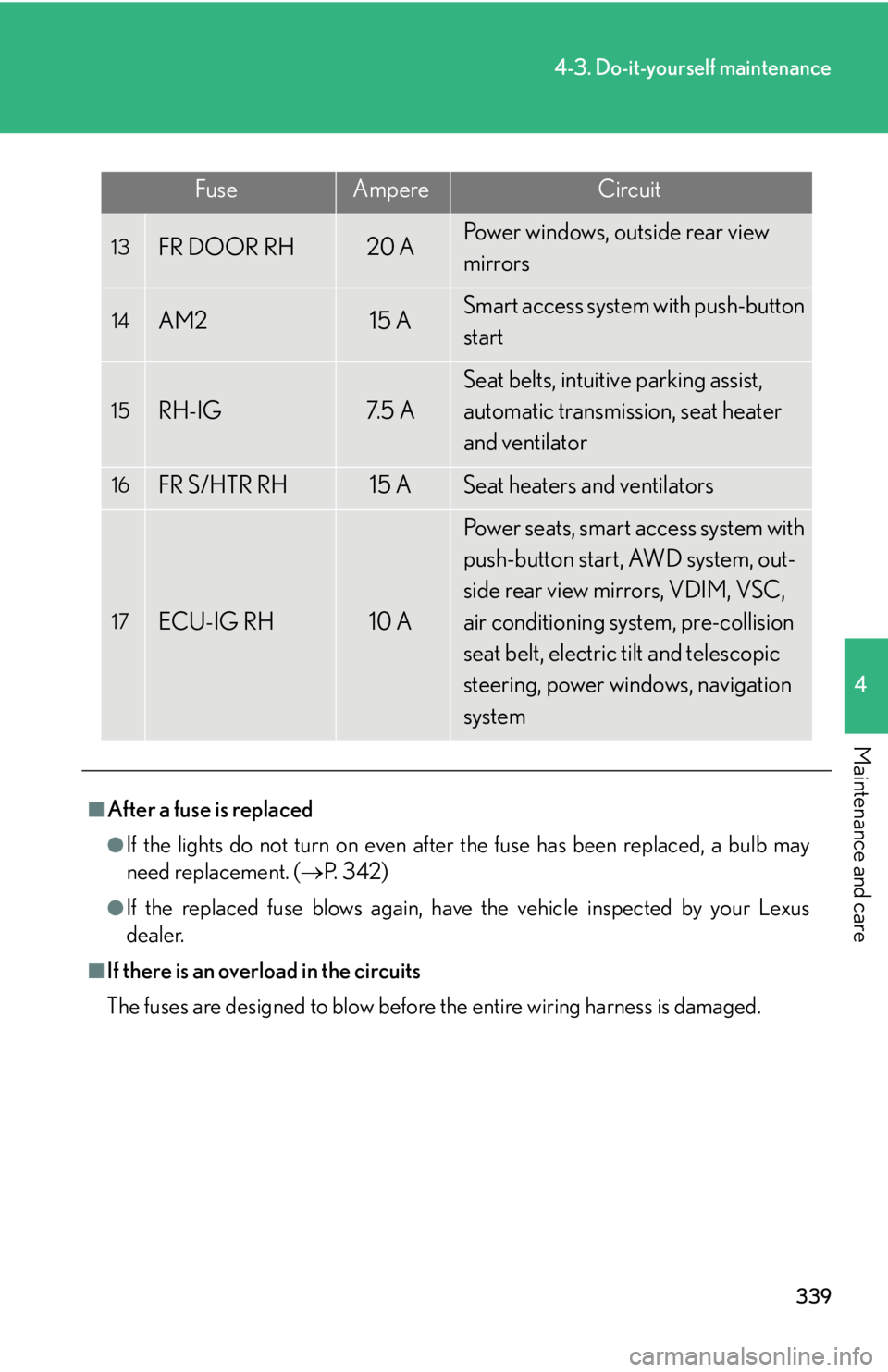
339
4-3. Do-it-yourself maintenance
4
Maintenance and care
FuseAmpereCircuit
13FR DOOR RH20 APower windows, outside rear view
mirrors
14AM215 ASmart access system with push-button
start
15RH-IG7. 5 A
Seat belts, intuitive parking assist,
automatic transmission, seat heater
and ventilator
16FR S/HTR RH15 ASeat heaters and ventilators
17ECU-IG RH10 A
Power seats, smart access system with
push-button start, AWD system, out-
side rear view mirrors, VDIM, VSC,
air conditioning system, pre-collision
seat belt, electric tilt and telescopic
steering, power windows, navigation
system
■After a fuse is replaced
●If the lights do not turn on even after the fuse has been replaced, a bulb may
need replacement. ( P. 3 4 2 )
●If the replaced fuse blows again, have the vehicle inspected by your Lexus
dealer.
■If there is an overload in the circuits
The fuses are designed to blow before the entire wiring harness is damaged.
Page 350 of 464

350
5-1. Essential information
If your vehicle needs to be towed
Before towingThe following may indicate a problem with your transmission. Contact
your Lexus dealer before towing.
● The engine is running, but the vehicle will not move.
● The vehicle makes an abnormal sound.
Emergency towing
If a tow truck is not available, in an emergency your vehicle may be tem-
porarily towed using a cable or chain secured to the emergency towing
eyelet(s). This should only attempted on hard, surfaced roads for short
distances at low speeds.
A driver must be in the vehicle to s teer and operate the brakes. The vehi-
cle’s wheels, drive train, axles, steering and brakes must be in good condi-
tion.
Towing eyelets
If towing is necessary, we recommend having your vehicle towed by your
Lexus dealer or a commercial towing se rvice, using a lift-type truck or a flat
bed truck.
Use a safety chain system for all towi ng, and abide by all state/provincial
and local laws.
If towing from the rear, the vehicle’s front wheels and axles must be in good
condition. ( P. 3 5 4 )
If they are damaged, use a to wing dolly or flat bed truck.
Page 351 of 464
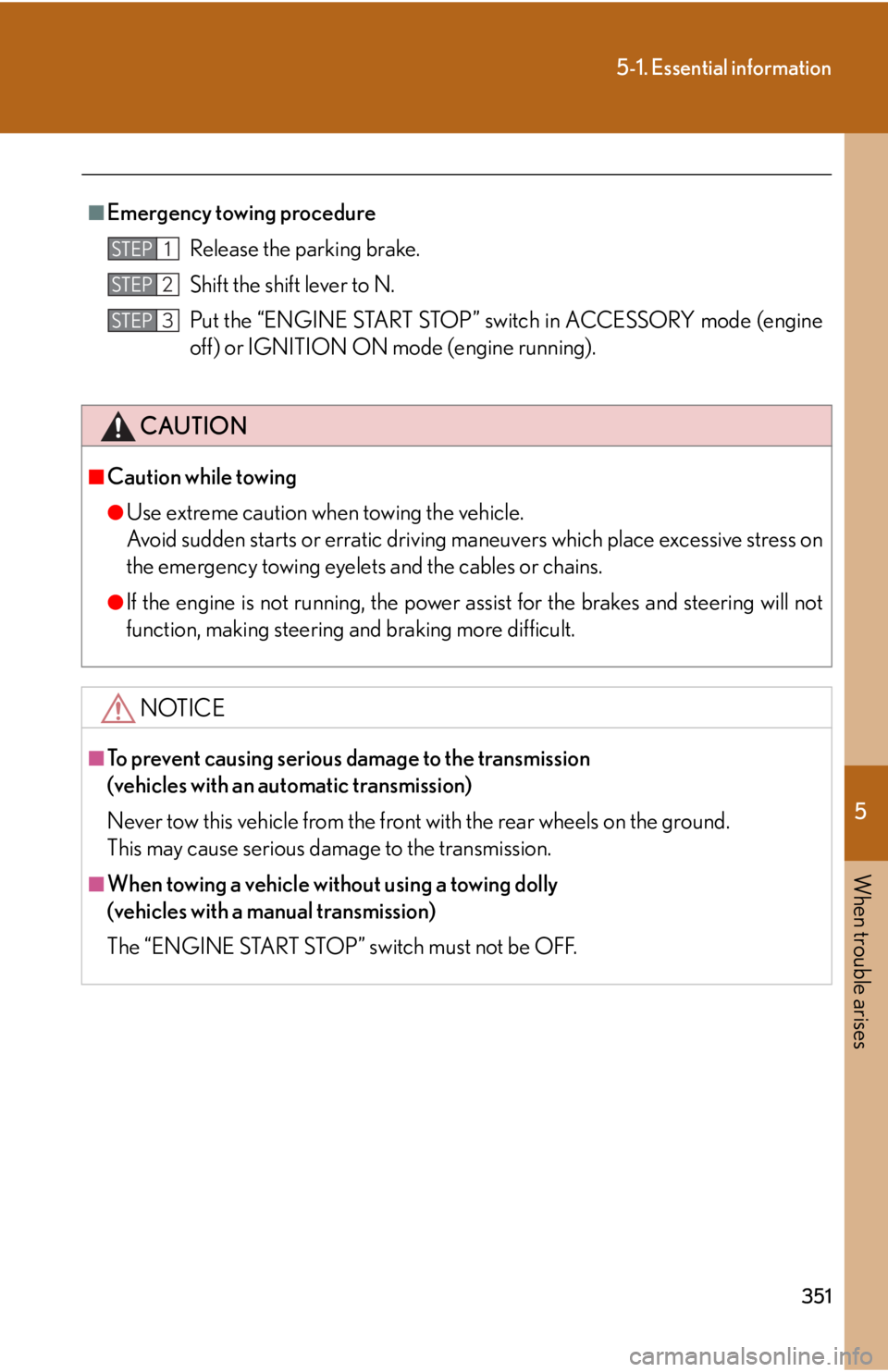
5
When trouble arises
351
5-1. Essential information
■Emergency towing procedureRelease the parking brake.
Shift the shift lever to N.
Put the “ENGINE START STOP” switch in ACCESSORY mode (engine
off) or IGNITION ON mode (engine running).
CAUTION
■Caution while towing
●Use extreme caution when towing the vehicle.
Avoid sudden starts or erratic driving maneuvers which place excessive stress on
the emergency towing eyelets and the cables or chains.
●If the engine is not running, the power assi st for the brakes and steering will not
function, making steering and braking more difficult.
NOTICE
■To prevent causing serious damage to the transmission
(vehicles with an automatic transmission)
Never tow this vehicle from the front with the rear wheels on the ground.
This may cause serious dama ge to the transmission.
■When towing a vehicle without using a towing dolly
(vehicles with a manual transmission)
The “ENGINE START STOP” switch must not be OFF.
STEP1
STEP2
STEP3
Page 354 of 464

354
5-1. Essential information
Towing with a wheel lift-type truckFrom the front Vehicles with an automatic trans-
mission: Use a towing dolly under
the rear wheels.
Vehicles with a manual transmis-
sions: We recommend to use a
towing dolly under the rear wheels.
When not using a towing dolly,
release the parking brake and shift
the shift lever to N.
From the rear (2WD models)Switch to ACCESSORY mode so
that the steering wheel is
unlocked.
From the rear (AWD models) Use a towing dolly under the front
wheel.
Page 355 of 464

5
When trouble arises
355
5-1. Essential information
Using a flat bed truckIf your Lexus is transported by a
flat bed truck, it should be tied
down at the locations shown in the
illustration.
If you use chains or cables to tie
down your vehicle, the angles
shaded in black must be 45 .
Do not overly tighten the tie downs
or the vehicle may be damaged.
NOTICE
■To prevent causing serious damage to the transmission
(vehicles with an automatic transmission)
Never tow this vehicle from the front with the rear wheels on the ground.
■To prevent damaging the vehicle
●Do not tow the vehicle from the rear with the “ENGINE START STOP” switch
OFF.
The steering lock mechanism is not st rong enough to hold the front wheel
straight.
●When raising the vehicle from the rear, ensure adequate ground clearance for
towing at the opposite end of the raised vehicle. Without adequate clearance, the
vehicle could be damaged while being towed from the rear.